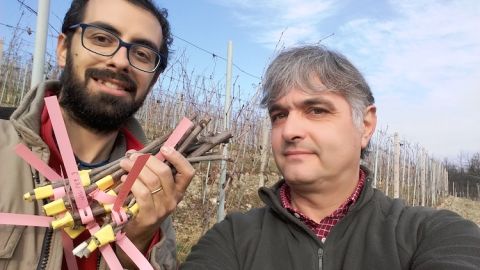From €15, £16.50, $32.90.
Five years ago I reported here on a modest event held in the magnificent Castello di Grinzane in the village of the same name in Barolo, in which a private producers' association, Indigenous Langa, launched its foundation with a blind tasting of the obscure white-wine grape Nascetta.
The main goal of the newly minted association was and still is to draw attention to little-known, rare local grape varieties threatened with extinction, such as Nascetta, in an effort to rescue and promote them.
Indigenous Langa was instrumental in getting Nascetta officially registered in Italy's national grape varieties register, without which it is impossible to produce and market wine from any variety legally. After its registration Nascetta became a permitted variety within the Langhe DOC, joining the hotchpotch of grape varieties allowed in the Langhe, a list so extensive it is more like an IGT (a vino da tavola with a geographical origin) rather than the higher-level denominazione – the result of an attempt to avoid IGTs in Piemonte, the only region in Italy not to have any at all.
Luckily, the association was able to push for the creation of an official, very small, subzone, the village of Novello, the historic epicentre of Nascetta, where it has been cultivated for at least 150 years, but probably much longer. This official subzone, called Nascetta del comune di Novello, comes with stricter production rules than Langhe DOC, the most important being that the wines must be 100% Nascetta as opposed to 85% under the Langhe DOC.
In Novello one estate in particular, Le Strette, run by brothers Savio and Mauro Daniele, has gone the extra mile while making considerable investments in Nascetta. Le Strette produces Barolos full of personality, but so far the estate has remained a little under the radar because although their vineyards, Bergera-Pezzole and Corrini Pallaretta, are historic crus, they were practically forgotten and neglected over time until the Daniele brothers took them on.
In 2014, the Daniele brothers discovered, just steps away from the confines of the Barolo denomination and immediately south of Novello, an 80-year-old Nascetta vineyard on the same white chalky-clay soils that make Barolo so famous and on which Nascetta also thrives. Like Nebbiolo, Nascetta is a prima donna of a variety which needs full southern exposure and a ventilated but not windy spot on calcareous clay. The Danieles found this spot (pictured above) on the Pasinotti hill, historically an important Nascetta site, but, except for this tiny plot, the vineyard area had been neglected for years and was overgrown with shrubs.
Knowing the historic relevance of the place, the Danieles left nothing to chance, bought 5 ha (12 acres) and immediately cleared the abandoned vineyards of bushes and shrubs. Subsequently, 29 different cuttings were taken from several patches of old vines, from which a collection of 750 Nascetta vines was planted in order to study and protect possible different Nascetta clones. The project was overseen by Dr Stefano Raimondi, a researcher at the Isituto per la Protezione Sostenibile delle Piante (the Institute of Plant Protection and Sustainability), and a department within the Consiglio Nazional delle Ricerche (CNR, the National Research Council), the largest public research institution in Italy. Nascetta is taken that seriously here.
Because it is an ancient variety, Nascetta is also known as Nascette, Anascetta and Danascetta. Both Nascetta as Nas-cëtta are legally allowed to be used on labels, while Anas-Cëtta was first used by Elvio Cogno to bypass the law and put the variety’s name on the label before it was officially registered and allowed.
At Le Strette, a first Nascetta already saw the light of day at the beginning of the 2000s, while in 2015 the first wine from the Pasinotti hill was produced. This year the first edition, a 2018, of a Nascetta from the vineyard, called Pasinot, has been released. Although every vintage of Le Strette's Nascetta that I tasted has more than convinced me, Pasinot is in a league of its own. My tasting note reads:
Gorgeous nose of white fruit, quince and acacia honey with saline notes pulled together by notes of breadcrumbs, which had me fooled this had been in oak, but this has seen only stainless steel. Ripe white fruit, mandarin and cut orange on the palate. Gorgeous length and style. This will go much further with bottle age. Without a shadow of a doubt Le Strette are the Nascetta specialists. You simply can't go wrong here. 17.5 Drink 2020–30
The alcohol level is 13.5%, which fits like a glove, and, although it is quite irresistible right now, it will keep for at least six more years and probably much longer. With Pasinot, Le Strette has created a monument for Nascetta and set the bar very high.
Wine-Searcher records listings in Italy for both the 2019 and the 2017 Le Strette Nascetta but not the 2018. The 2018 is available at Eataly in the US, and both 2018 and 2019 are available from Wanderlust Wine in the UK, who also have limited quantities of the Pasinot.















